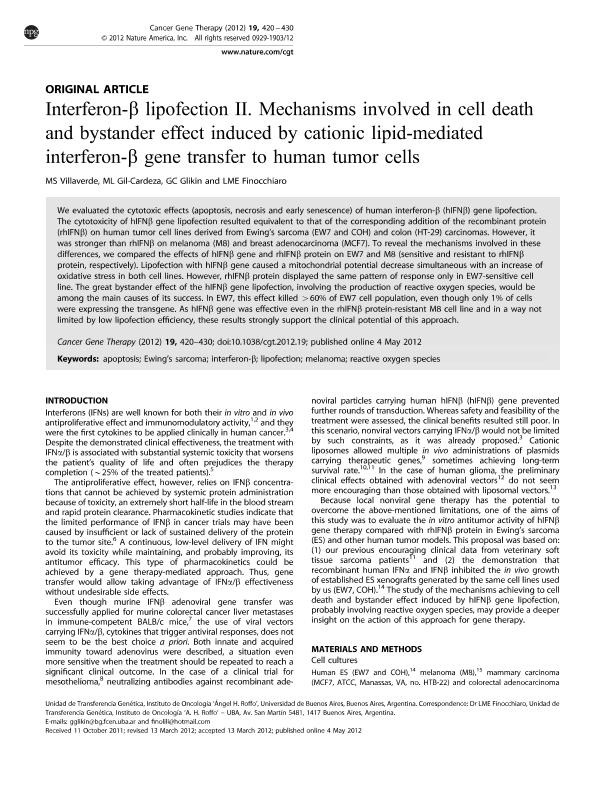Artículo
Interferon-Β lipofection II: Mechanisms involved in cell death and bystander effect induced by cationic lipid-mediated interferon-Β gene transfer to human tumor cells
Villaverde, Marcela Solange ; Gil Cardeza, Maria Lourdes
; Gil Cardeza, Maria Lourdes ; Glikin, Gerardo Claudio
; Glikin, Gerardo Claudio ; Finocchiaro, Liliana Maria Elena
; Finocchiaro, Liliana Maria Elena
 ; Gil Cardeza, Maria Lourdes
; Gil Cardeza, Maria Lourdes ; Glikin, Gerardo Claudio
; Glikin, Gerardo Claudio ; Finocchiaro, Liliana Maria Elena
; Finocchiaro, Liliana Maria Elena
Fecha de publicación:
06/2012
Editorial:
Nature Publishing Group
Revista:
Cancer Gene Therapy
ISSN:
0929-1903
Idioma:
Inglés
Tipo de recurso:
Artículo publicado
Clasificación temática:
Resumen
We evaluated the cytotoxic effects (apoptosis, necrosis and early senescence) of human interferon-B (hIFNB) gene lipofection. The cytotoxicity of hIFNB gene lipofection resulted equivalent to that of the corresponding addition of the recombinant protein (rhIFNB) on human tumor cell lines derived from Ewing´s sarcoma (EW7 and COH) and colon (HT-29) carcinomas. However, it was stronger than rhIFNB on melanoma (M8) and breast adenocarcinoma (MCF7). To reveal the mechanisms involved in these differences, we compared the effects of hIFNB gene and rhIFNB protein on EW7 and M8 (sensitive and resistant to rhIFNB protein, respectively). Lipofection with hIFNB gene caused a mitochondrial potential decrease simultaneous with an increase of oxidative stress in both cell lines. However, rhIFNB protein displayed the same pattern of response only in EW7-sensitive cell line. The great bystander effect of the hIFNB gene lipofection, involving the production of reactive oxygen species, would be among the main causes of its success. In EW7, this effect killed >60% of EW7 cell population, even though only 1% of cells were expressing the transgene. As hIFNB gene was effective even in the rhIFNB protein-resistant M8 cell line and in a way not limited by low lipofection efficiency, these results strongly support the clinical potential of this approach.
Archivos asociados
Licencia
Identificadores
Colecciones
Articulos(OCA HOUSSAY)
Articulos de OFICINA DE COORDINACION ADMINISTRATIVA HOUSSAY
Articulos de OFICINA DE COORDINACION ADMINISTRATIVA HOUSSAY
Citación
Villaverde, Marcela Solange; Gil Cardeza, Maria Lourdes; Glikin, Gerardo Claudio; Finocchiaro, Liliana Maria Elena; Interferon-Β lipofection II: Mechanisms involved in cell death and bystander effect induced by cationic lipid-mediated interferon-Β gene transfer to human tumor cells; Nature Publishing Group; Cancer Gene Therapy; 19; 6; 6-2012; 420-430
Compartir
Altmétricas



